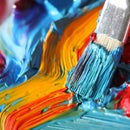Introduction: Screen Printing
I'll show you step by step on how to screen print using the photo emulsion technique.
Step 1: Supplies:
Screen printing screen: Speedball - can be found at Hobby Lobby, or online
Speedball DIAZO photo emulsion kit
Masking tape
Squeegee
Transparency of the image you want to print
Dark closet
150 watt bulb
Portable shop light (Home Depot)
Flat surface with dark fabric (I use a lid to a big storage container and navy fabric)
Glass (picture frame glass is fine, it is used to flatten transparency when exposing screen)
Handheld shower head or sprayer from the sink or pressure washer
Speedball fabric printing ink (don't try using any fabric paint, this ink is thicker for printing purposes. Regular fabric paint is thin and will not give you an opaque end result. Also, acrylic paint does not hold up to multiple washes - trust me)
Tshirts (I get mine from shirtchamp.com - great prices and quick shipping - I get the Gildan Heavy Cotton™ 5.3 oz. T-Shirt - G500 (5000))
Iron
Step 2: Preparing Your Screen
Your screen will not be prepared when you first buy it. You need to apply masking tape to the inside and back as shown to stop the flow of the emulsion when preparing your screen.
Step 3: Emulsion
Mix the emulsion as instructed, then pour onto screen.
Step 4: Spreading Emulsion
Using the squeegee, spread the emulsion on both sides of the screen. Because it is a liquid, on a screen, the emulsion will seep through to the other side when spreading.
Your screen should be as even as possible, hold it up to light to see if it smooth and all areas are covered.
*This does not have to be done in a dark room (as most photo emulsion would need to be kept in dark). The emulsion aspect does not take effect until the screen dries.
Step 5: Drying Screen
Put the screen, flat side up, in a dark room to dry. I use a small fan to circulate air so it will dry faster, but it is not necessary. Without a fan, it will take about 3 hours to dry.
Step 6: Print Your Transparency
You will need a transparency of the image you want to print. Make sure the image is in black.
Step 7: Exposing Your Screen
On the flat side of the screen, place the transparency UPSIDE DOWN on the screen then put the piece of glass on top to ensure the transparency is flat against the screen.
You put the transparency upside down because the flat side of the screen is the back side. Trust me, it will all make sense later.
Expose the screen with the light about 2 ft away, for 13-14 minutes. Make sure to time it because an over exposed screen will not wash clean for printing.
Step 8: Checking Your Screen
Once the time is up, turn the light off and remove the transparency and glass. It may not look like anything happened, but when you hold the screen to a light, you will see a difference in color.
By exposing the screen to the light source with the transparency, a reaction occurs. The exposed area becomes hardened and will not wash away. The unexposed area (the image on the transparency) is still soft enough to wash out in the next step.
Step 9: Cleaning Your Screen
Using either a handheld shower head, sink sprayer or pressure washer, clean your screen. All you need is water and pressure. Don't worry, the only part that will wash away is where the screen was not exposed to light.
Once clean, hold up to light to see if you missed any spots.
Don't worry, if you see any areas on your screen with "holes" (gaps in design or missed coverage of emulsion), just cover with masking tape on the back side of the screen once the screen is dry.
Step 10: Preparing to Print
Use cardboard or any stiff object in between the front and back of your shirt. I use old vinyl album sleeves becacue they are smooth and the perfect size. Don't use corrugated cardboard because the surface may be smooth, but when pressing down to ink your shirt, the waves of the corrugation will show as a pattern.
The reason you use a surface in between the layers is because you don't want the ink to bleed through to the opposite side of the shirt.
*Note: The "Pretty In Pink" cover was a happy accident when taking pictures for this Instructable.
Step 11:
Place your screen, flat side down on your shirt. Using the flat side allows the screen to make a direct connection for printing (like when using the glass on the transparency for exposing your screen)
Step 12: Ink the Image
Using a spoon, put a glob of ink on the screen. I drag my glob across the top for even coverage.
Use the squeegee to ink the design onto the shirt.
** Don't go OCD when using the squeegee. Just make sure it covers the design and stop! Too much will cause over-inking and you will lose the sharpness of the design.
Step 13: Finishing
Pull the screen off, lifting from right to left to reveal your design.
Once 100% dry, iron the image using the highest setting before steam. Iron for 10-15 seconds on all areas of the design. I usually place the iron on one half (no need to apply pressure, just place directly on top of the ink) for 10-15 seconds then move the iron to the other half. This will set the ink and now the design will not wash off.
DONE!





